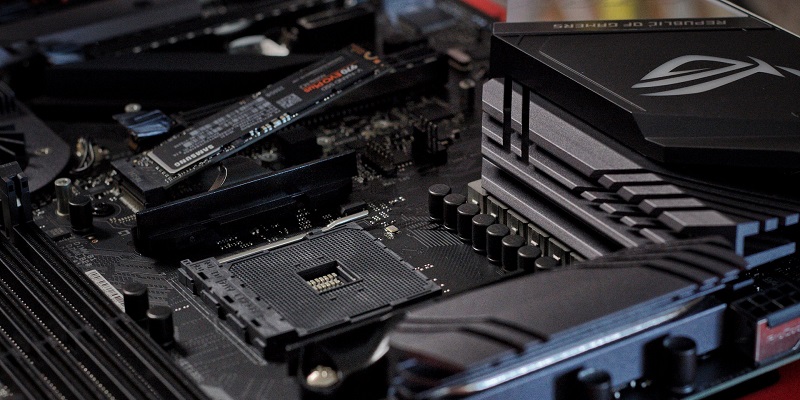The AMD Ryzen 7000 CPU and AM5 motherboards have been on the market for a while now and have been praised for their performance and speed. However, the AM5 platform has caused significant problems for users due to its EXPO memory feature.
EXPO is a major marketing feature for the AM5 platform, which, when enabled, can cause permanent damage to PCs. The voltage limit for EXPO is set at 1.3V, but most new BIOS fails to adhere to this limit, leading to burnouts. Customers were misled into thinking that they were safe with the new BIOS and were offered no warranty support after permanent damage was caused by the EXPO feature.
Rushed BETA BIOS Updates Rolled Out by ASUS Following AMD Ryzen 7000 CPU and Motherboard Burnout Issues
ASUS was quick to respond to the issue, rolling out two rushed BETA BIOS updates to address the burnout problems. However, the new BIOS failed to limit the voltage to 1.3V when running EXPO memory, leading to further burnouts. As a result, many users complained about damaged CPUs and motherboards, leading to a loss of trust in the company.
Running EXPO memory below 1.3V can cause burnouts, while most new BIOS fail to adhere to the voltage limit
A new report by Hardware Busters, a respected hardware benchmarking company, has revealed that ASUS and Gigabyte misled their customers about the voltage limit while promoting EXPO. Most new BIOS failed to hit the voltage limit of 1.3V when running EXPO memory, which caused burnouts. This has led to questions about the quality control and testing procedures of both companies, as well as their commitment to customer safety.
Hardware Busters Report Reveals ASUS and Gigabyte Misled Customers About Voltage Limit While Promoting EXPO
The report by Hardware Busters showed that customers were misled into believing that their systems were safe with the new BIOS. ASUS and Gigabyte failed to provide accurate information about the voltage limit, leading to permanent damage to PCs. Both companies have a responsibility to ensure that their products are of high quality and safe for use by consumers. The report has also raised questions about the effectiveness of the testing procedures employed by these companies.
Gigabyte’s new BIOS, F10D, still exceeds voltage limits despite claims of fixing the issue
Gigabyte claimed to have fixed the voltage limit issue with its new BIOS, F10D. However, Hardware Busters found that the new BIOS still exceeded the voltage limit, further damaging systems. The AORUS Master X670E motherboard, in particular, drew 1.416V when running Prime95 with EXPO enabled, while the limit is supposed to be 1.3V. This led to a loss of trust in the company and questions about their commitment to customer safety.
Customers who have been misled are offered no warranty support after permanent damage is caused by the EXPO feature
The worst part of the situation is that customers, who experienced permanent damage due to the EXPO feature, were offered no warranty support. ASUS and Gigabyte failed to take ownership of the issue, leading customers to incur additional costs to replace damaged components. This has caused further damage to the companies’ reputations and raised questions about their commitment to customer service.
EXPO is a major marketing feature for the AM5 platform, but when enabled, it can lead to permanent damage to PCs
EXPO is a significant marketing feature for the AM5 platform, which has led to noteworthy concerns for users. While its performance benefits are evident, the risks associated with its use have resulted in permanent damage in many cases. The voltage limit of 1.3V must be strictly adhered to, and proper warnings should be provided to users who wish to enable the EXPO feature.
AMD is also partly to blame for allowing users to purchase expensive DDR5 memory sticks without proper warning about potential damage
AMD is also partly to blame for allowing users to buy expensive DDR5 memory sticks without proper warning about potential damage. Users were unaware of the risks associated with the XMP feature, and AMD did little to educate them. This has led to a loss of trust in the company as well.
Wait for the newer BIOS update set to roll out later this month.
It is worth waiting for the newer BIOS update, which is expected to roll out later this month. The update is expected to address the voltage limit issue and provide users with a safe experience. However, it is uncertain whether the new BIOS will address all the issues that customers have faced with the AM5 platform.
Uncertainty remains whether the new BIOS will address all the issues with the AM5 platform
Overall, the AM5 platform has significant problems that need to be addressed by all companies involved. ASUS and Gigabyte have misled their customers about the voltage limit while promoting EXPO, leading to permanent damage to PCs. AMD is also partly responsible for not providing proper warnings about the potential risks associated with the EXPO feature.
Users are eagerly awaiting the new BIOS update, which is expected to address the voltage limit issue. However, there remains uncertainty about whether the new BIOS will address all issues that customers have faced with the AM5 platform. Companies should prioritize customer safety and provide accurate information about their products to avoid such problems in the future.

